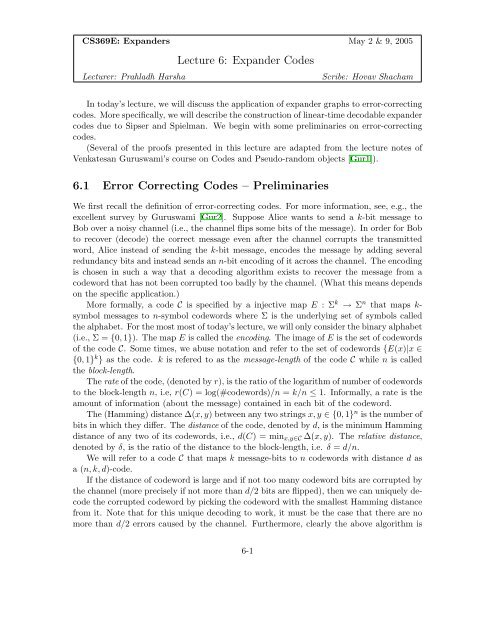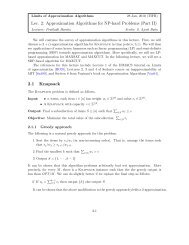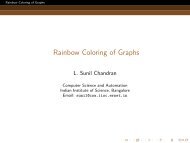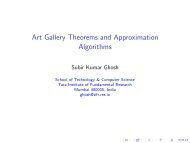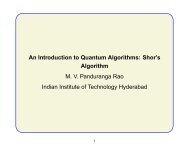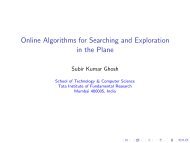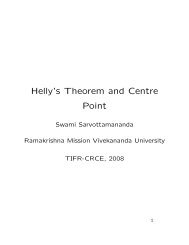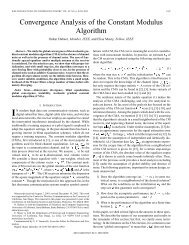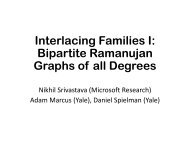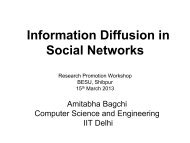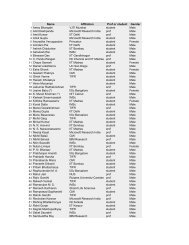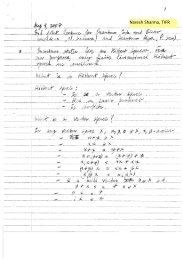Lecture 6: Expander Codes 6.1 Error Correcting Codes â Preliminaries
Lecture 6: Expander Codes 6.1 Error Correcting Codes â Preliminaries
Lecture 6: Expander Codes 6.1 Error Correcting Codes â Preliminaries
Create successful ePaper yourself
Turn your PDF publications into a flip-book with our unique Google optimized e-Paper software.
CS369E: <strong>Expander</strong>s May 2 & 9, 2005<br />
<strong>Lecture</strong>r: Prahladh Harsha<br />
<strong>Lecture</strong> 6: <strong>Expander</strong> <strong>Codes</strong><br />
Scribe: Hovav Shacham<br />
In today’s lecture, we will discuss the application of expander graphs to error-correcting<br />
codes. More specifically, we will describe the construction of linear-time decodable expander<br />
codes due to Sipser and Spielman. We begin with some preliminaries on error-correcting<br />
codes.<br />
(Several of the proofs presented in this lecture are adapted from the lecture notes of<br />
Venkatesan Guruswami’s course on <strong>Codes</strong> and Pseudo-random objects [Gur1]).<br />
<strong>6.1</strong> <strong>Error</strong> <strong>Correcting</strong> <strong>Codes</strong> – <strong>Preliminaries</strong><br />
We first recall the definition of error-correcting codes. For more information, see, e.g., the<br />
excellent survey by Guruswami [Gur2]. Suppose Alice wants to send a k-bit message to<br />
Bob over a noisy channel (i.e., the channel flips some bits of the message). In order for Bob<br />
to recover (decode) the correct message even after the channel corrupts the transmitted<br />
word, Alice instead of sending the k-bit message, encodes the message by adding several<br />
redundancy bits and instead sends an n-bit encoding of it across the channel. The encoding<br />
is chosen in such a way that a decoding algorithm exists to recover the message from a<br />
codeword that has not been corrupted too badly by the channel. (What this means depends<br />
on the specific application.)<br />
More formally, a code C is specified by a injective map E : Σ k → Σ n that maps k-<br />
symbol messages to n-symbol codewords where Σ is the underlying set of symbols called<br />
the alphabet. For the most most of today’s lecture, we will only consider the binary alphabet<br />
(i.e., Σ = {0, 1}). The map E is called the encoding. The image of E is the set of codewords<br />
of the code C. Some times, we abuse notation and refer to the set of codewords {E(x)|x ∈<br />
{0, 1} k } as the code. k is refered to as the message-length of the code C while n is called<br />
the block-length.<br />
The rate of the code, (denoted by r), is the ratio of the logarithm of number of codewords<br />
to the block-length n, i.e, r(C) = log(#codewords)/n = k/n ≤ 1. Informally, a rate is the<br />
amount of information (about the message) contained in each bit of the codeword.<br />
The (Hamming) distance ∆(x, y) between any two strings x, y ∈ {0, 1} n is the number of<br />
bits in which they differ. The distance of the code, denoted by d, is the minimum Hamming<br />
distance of any two of its codewords, i.e., d(C) = min x,y∈C ∆(x, y). The relative distance,<br />
denoted by δ, is the ratio of the distance to the block-length, i.e. δ = d/n.<br />
We will refer to a code C that maps k message-bits to n codewords with distance d as<br />
a (n, k, d)-code.<br />
If the distance of codeword is large and if not too many codeword bits are corrupted by<br />
the channel (more precisely if not more than d/2 bits are flipped), then we can uniquely decode<br />
the corrupted codeword by picking the codeword with the smallest Hamming distance<br />
from it. Note that for this unique decoding to work, it must be the case that there are no<br />
more than d/2 errors caused by the channel. Furthermore, clearly the above algorithm is<br />
6-1
not efficient as we need to search over the entire space {0, 1} n to find the nearest codeword.<br />
In today’s lecture, we will describe a code (based on expanders) for which this decoding can<br />
be done efficiently (more precisely in time linear in the length of the codeword).<br />
Linear Code A code C is linear if 0 n is (a codeword) in C and if, whenever x and y are<br />
in C, so is x ⊕ y 1 . Linear codes are usually defined in the more general setting when the<br />
underlying alphabet for the codeword is some finite field, however for the purpose of this<br />
lecture we will restrict ourselves to the binary alphabet {0, 1}. We refer to a linear code<br />
that maps k message bits to n codeword bits with distance d as a [n, k, d]-code.<br />
It is an easy observation that , in a linear code, d equals the smallest Hamming weight<br />
of a non-zero codeword. A linear code can be described as an n × k generator matrix C<br />
(such that Cm ∈ {0, 1} n is the codeword corresponding to a message m ∈ {0, 1} k ), or<br />
by an (n − k) × n parity-check matrix H (such that x ∈ {0, 1} n is a codeword whenever<br />
Hx equals 0 n−k ). The existence of a generator matrix C immediately implies that the<br />
encoding time for linear codes is at most quadratic. The parity check-matrix H implies<br />
that a [n, k, d]-code can be described by the n − k = n(1 − r) linear constraints (i.e., the<br />
columns of H) imposed on the codewords bits. Conversely, if a linear code is described by<br />
a set of t (consistent) linear equations, then the rate of the code is at least r ≥ 1 − t/n.<br />
A random [n, k, d]-linear code is formed by choosing a random n × k generator matrix<br />
C of zeros and ones (where each entry is chosen to be either 0 or 1 with probability 1/2)<br />
and defining the code C accordingly (i.e, setting E(x) = Cx, ∀x ∈ {0, 1} k ). The Gilbert-<br />
Varshamov bound states that such a random linear code has (with high probability) distance<br />
δ if the block-length ( ) is at least( n ≥ k/(1 ) − H(δ)) where H(·) is the binary entropy function<br />
H(p) = p log 1<br />
p<br />
+ (1 − p) log 1<br />
1−p<br />
.<br />
Theorem <strong>6.1</strong> (Gilbert-Varshamov). Let δ < 1 2<br />
. If C is a random linear code with rate at<br />
most 1 − H(δ), then<br />
Prob [d(C) ≥ δ] = 1 − o(1).<br />
6.2 <strong>Expander</strong> based codes<br />
We now present the expander codes of Sipser and Spielman [SS]. These expander codes<br />
have the advantage that the decoding process is very efficient, can be performed in linear<br />
time on a single processor or in log n time by a parallel processor with n-machines. We<br />
describe the construction due to Zémor [Zém] which is a slight modification of the original<br />
construction of Sipser and Spielman [SS]<br />
6.2.1 Zémor <strong>Codes</strong> – construction<br />
The family of expander codes is parametrized by a fixed-size code C with some small blocklength<br />
d and a family expander graph G n on n vertices with constant degree d. The construction<br />
due to Zémor is specified by a process that converts a fixed-size code C of block-length<br />
d and an expander graph G on n vertices and degree d into a new code Z = Z(C, G) with<br />
1 where ⊕ refers to the bit-wise xor operation<br />
6-2
lock-length nd. The rate and distance of the new code Z depend on the rate and distance<br />
r and δ of C, and on the spectral expansion λ of G.<br />
The construction proceeds as follows. Take the graph G = (V, E), and duplicate its<br />
vertex set V into left and right vertex sets L and R. For an edge e ∈ E with endpoints<br />
u and v in V , connect both u L in L to v R in R and v L in L to u R in R. This creates a<br />
d-regular 2n-vertex bipartite graph G ′ . Since the graph G ′ is constructed from an expander<br />
G with spectral expansion λ, the expander mixing lemma can be applied to this graph. In<br />
other words, for all sets S ⊂ L and T ⊂ R, we have that<br />
|<br />
∣e(S, t) − d|S||T n ∣ ≤ λd√ |S||T |,<br />
where e(S, T ) represents the number of edges between the sets S and T .<br />
Now we will use the new graph G ′ to describe codewords in Z. These codewords are<br />
dn bits long, and G ′ has dn edges. We will associate each bit position in the codeword with<br />
an edge in G ′ . It is thus possible to consider a codeword x as an assignment of ones and<br />
zeroes to the edges in G ′ . Moreover, for each vertex v (on either side) we can consider the<br />
d-bit restriction x v of x to edges incident on v. For this purpose, we assume some canonical<br />
ordering among the edges incident on any vertex. If x ∈ {0, 1} dn and e 1 , . . . , e d are the edges<br />
incident on vertex v, then x v = (x e1 , . . . , x ed ) ∈ {0, 1} d . Observe that this association also<br />
works if x is not a proper codeword: for example, if it has been corrupted by the channel.<br />
Given these mappings, the code itself is actually quite simple. A bit string x ∈ {0, 1} dn<br />
is a codeword in Z if, for each vertex v ∈ L ∪ R, x v is a codeword in C. Note that each edge<br />
label must satisfy constraints imposed by both its left and right endpoint.<br />
If C is a linear code, then so is Z. The following theorem characterizes Z in terms of<br />
C and G.<br />
Theorem 6.2. Suppose Cis a [d, rd, δd]-code with rate r < 1/2 and G is a d-regular expander<br />
on n vertices with spectral expansion λ < δ. Then Z(C, G) is a [dn, (2r − 1)dn, δ(δ − λ)dn]-<br />
code.<br />
Proof. It is clear that block length of Z is dn.<br />
The codes C and Z are linear, and so we can consider their rates in terms of constraints<br />
in their parity-check matrices. Since C has block-length d and rate r, its parity-check<br />
matrix imposes at most d − rd = (1 − r)d constraints on codewords. These constraints are<br />
imposed in Z at each of the 2n vertices, so the total number of constraints in Z is at most<br />
2n(1 − r)d = ( 1 − (2r − 1) ) nd, and Z’s rate is at least (2r − 1).<br />
Since Z is linear, its distance equals the minimum Hamming weight of a non-zero codeword.<br />
Consider such a codeword x. Let X be the edges labeled 1 in x: X = {e | x e = 1},<br />
and let S and T be the sets of left- and right-hand vertices, respectively, on which edges<br />
in X are incident.<br />
The degree of X with respect to vertices in S and T must be at least δd, since otherwise<br />
x would not locally be a C-codeword at these vertices. With a factor of 2 to allow for the<br />
double-counting of edges, we have that<br />
|X| ≥ δd (|S| + |T |) . (1)<br />
2<br />
6-3
However, by the <strong>Expander</strong> Mixing Lemma, we have<br />
|X| ≤ e(S, T ) ≤ d n |S||T | + λd√ |S||T | .<br />
Combining the inequalities and dividing out d yields<br />
δ<br />
2 (|S| + |T |) < 1 n |S||T | + λ√ |S||T | .<br />
We can simplify this inequality by means of the following AM-GM inequality<br />
|S||T | ≤<br />
(|S| + |T |)2<br />
4<br />
, (2)<br />
obtaining<br />
δ<br />
1<br />
(|S| + |T |) <<br />
2 4n (|S| + |T |)2 + λ (|S| + |T |) ,<br />
2<br />
or, after some algebra,<br />
|S| + |T | > 2n(δ − λ) ; (3)<br />
Substituting 3 into (1) shows that Z’s distance is at least δ(δ − λ)dn, as required.<br />
6.2.2 Decoding Algorithm<br />
We now consider how one might decode corrupted codewords in the code Z(C, G). The<br />
algorithm we give has the considerable advantage of being local: at each round, algorithm<br />
choices at a node depend only values local to that node. In a distributed or multi-processing<br />
environment, these local choices can all be made in parallel. It will be evident from the<br />
algorithm below, how the decoding can be implemented in O(log n) time on a parallel<br />
machine with n machines. To obtain a linear-time decoding algorithm (on a single machine),<br />
a little more book-keeping is necessary. However, for today’s lecture, we will ignore this<br />
book-keeping (the details of which can be found in [BZ]).<br />
Algorithm <strong>6.1</strong> (Local Decoding for Z(C, G)). The algorithm is given as input a corrupted<br />
codeword x, interpreted as consisting of corrupted local codewords x v at vertices v in the left<br />
or right vertex sets L and R. It corrects these codewords locally as follows.<br />
1. Set V 0 ← L<br />
2. Set i ← 0<br />
3. while there exists a vertex v such that x v /∈ C do:<br />
(a) For each v ∈ V i such that x v /∈ C, decode x v to nearest codeword in C<br />
(b) If V i = L, set V i+1 ← R, otherwise set V i+1 ← L.<br />
(c) set i ← i + 1<br />
4. Return x<br />
6-4
Since all the choices in any single round of the algorithm can be carried out in parallel,<br />
we will analyze the algorithm in terms of the number of rounds before it converges on a<br />
codeword. In particular, we obtain the following theorem, parametrized on α, which can<br />
take values between 0 (faster convergence, but corrects less noise) and 1 (slower, but corrects<br />
more).<br />
Theorem 6.3. Suppose C is a [d, rd, δd]-code and G is a d-regular expander on n vertices<br />
with spectral expansion λ < δ/3. Then for all α, 0(<br />
≤ α ≤ ) 1, the decoding algorithm given<br />
in Algorithm <strong>6.1</strong> corrects α δ 2 ( δ 2 − λ)dn errors in O lg n<br />
rounds.<br />
lg(2−α)<br />
Proof. Because Z is linear, we can, wlog, assume that the closet codeword to the corrupted<br />
codeword x is the all-zeros codeword. Denote the working word after i rounds by x (i) .<br />
Thus, x (0) represents the initial corrupted codeword. Let E (i) be the edges labeled 1 after<br />
i rounds:<br />
{ }<br />
E (i) = e | x (i)<br />
e = 1 ,<br />
Thus, E (i) represents the codeword bits that haven’t been decoded correctly after i rounds.<br />
Let S (i) be the vertices in the set V i−1 (i.e., left or right side depending on i) with edges in<br />
E (i) , i.e., the vertices that have not yet correctly decoded at the end of the i rounds.<br />
{<br />
}<br />
S (i) = v ∈ V i−1 | E v ∩ E (i) ≠ ∅ .<br />
where E v represents the set of edges incident on v.<br />
By a series of claims, we will show a geometric decline in the size of S (i) ,<br />
proving the theorem.<br />
We first make some observations:<br />
|S (i+1) | < |S(i) |<br />
2 − α ,<br />
• Every edge in E (i) has at least one endpoint in S (i) .<br />
• With respect to E (i) , every vertex in S (i+1) has degree at least δd/2, since otherwise<br />
the vertex would have been locally decoded to the zero codeword in the (i+1) th round.<br />
Claim 6.4. |S (1) | ≤ α( δ 2 − λ)n.<br />
Proof. By assumption, |E (0) | ≤ α δ 2 ( δ 2 − λ)dn. By the observations above, |E(0) | ≥ |S (1) | δd 2 ;<br />
adjoining the two inequalities proves the claim.<br />
Claim 6.5. If δ > 3λ and |S (i) | < α( δ 2 − λ)n, then |S(i+1) | < |S(i) |<br />
2−α .<br />
Proof. Consider the edge set E(S (i) , S (i+1) ). This set certainly includes all edges in E (i)<br />
between S (i) and S (i+1) , and these number (by the observation) at least δd 2 |S(i+1) |. Thus<br />
we have<br />
e(S (i) , S (i+1) ) ≥ δd 2 |S(i+1) | .<br />
6-5
By the <strong>Expander</strong> Mixing Lemma, however, we have<br />
e(S (i) , S (i+1) ) ≤ d|S(i) ||S (i+1) √<br />
|<br />
+ λd |S<br />
n<br />
(i) ||S (i+1) | .<br />
Combining these inequalities, we obtain<br />
δd<br />
2 |S(i+1) | ≤ d|S(i) ||S (i+1) √<br />
|<br />
+ λd |S<br />
n<br />
(i) ||S (i+1) | ,<br />
and, using the AM-GM inequality (2) with S = S (i) and T = S (i+1) ,<br />
δd<br />
2 |S(i+1) | < d|S(i) ||S (i+1) |<br />
+ λd<br />
n 2 (|S(i) | + |S (i+1) |) .<br />
Applying the claim precondition |S (i) | < α( δ 2<br />
− λ)n to the first summand gives<br />
δd<br />
2 |S(i+1) | < αd( δ 2 − λ)|S(i+1) | + λd<br />
2 (|S(i) | + |S (i+1) |) ,<br />
which we can rearrange as<br />
(<br />
δ − α(δ − 2λ) − λ<br />
)<br />
|S (i+1) | < λ|S (i) | . (4)<br />
Using the other claim precondition, δ > 3λ, we see that<br />
δ − α(δ − 2λ) − λ = (1 − α)(δ − 2λ) + λ > (1 − α)λ + λ = (2 − α)λ ,<br />
which, applied to (4), gives (2 − α)|S (i+1) | < |S (i) |, which proves the claim.<br />
We have thus shown a geometric decline in the size of S (i) ;. Expressed in terms( of |S (1) ) |,<br />
|S (i) | drops exponentially as 1/(2 − α) i , and the algorithm will complete in O lg n<br />
lg(2−α)<br />
rounds.<br />
The above code and decoding algorithm, together with explicit constructions for C and<br />
G, give the following general theorem. We choose C to be a fixed-size linear code satisfying<br />
the Gilbert-Varshamov bound and G to be a family of Ramanujan graphs with λ ≈ 1/ √ d<br />
(in fact, any family of expander graphs with λ = 1/o(d) will suffice.<br />
Theorem 6.6 (Sipser and Spielman; Zémor). For all 0 < δ, ɛ < 1 such that 1−2H( √ δ) < 1,<br />
there exists an explicit family of codes with rate 1 − 2H( √ δ) and relative distance δ − ɛ,<br />
with a decoding algorithm that corrects δ/4 − ɛ errors in O(lg n) rounds, where n is the<br />
block-length of the code and H(·) is the binary entropy function.<br />
6.2.3 <strong>Expander</strong> codes with nearly optimal rate<br />
The condition 1 − 2H( √ δ) < 1 in Theorem 6.6 allows for only codes with relative distance<br />
δ < 0.0121 and thus allows error-recovery from a small fraction ≈ 1% of errors. <strong>Expander</strong>s<br />
and the expander mixing lemma can be used again (!!) to improve the relative distance to<br />
1/2 − ɛ and linear-time decoding upto 1/4 − ɛ fraction of errors at the cost of increasing the<br />
alphabet size from binary to a large constant depending on ɛ. This construction is due to<br />
Guruswami and Indyk [GI].<br />
6-6
Theorem 6.7 (Guruswami Indyk [GI]). For every 0 < r, ɛ < 1, there is an explicit infinite<br />
family of linear codes with rate r and relative distance at least (1 − r − ɛ) such that the codes<br />
in the family can be decoded from a fraction (1 − r − ɛ)/2 of errors in time linear in the<br />
block-length of the code.<br />
The details of this construction can be found in [Gur2, GI].<br />
References<br />
[BZ]<br />
Alexander Barg and Gilles Zémor, “<strong>Error</strong> Exponents of <strong>Expander</strong> <strong>Codes</strong>”, IEEE<br />
Transactions on Information Theory, 48(6):1725–1729 (2002).<br />
[Gur1] Venkatesan Guruswami, <strong>Lecture</strong> notes for a course on <strong>Codes</strong> and Pseudorandom<br />
objects, University of Washington, Seattle. http://www.cs.washington.edu/<br />
education/courses/590vg/03wi/notes.html<br />
[Gur2] Venkatesan Guruswami, “<strong>Error</strong>-correcting codes and <strong>Expander</strong> graphs”, SIGACT<br />
News, 35(3): 25–41, September 2004.<br />
[GI]<br />
[SS]<br />
Venkatesan Guruswami, Piotr Indyk, “Linear time encodable/decodable codes with<br />
near-optimal rate”, To appear in IEEE Transactions on Information Theory. (Preliminary<br />
Version in STOC’02).<br />
Michael Sipser, Daniel A. Spielman: “<strong>Expander</strong> codes”. IEEE Transactions on Information<br />
Theory 42(6): 1710–1722 (1996)<br />
[Zém] Gilles Zémor: “On <strong>Expander</strong> <strong>Codes</strong>”, IEEE Transactions on Information Theory<br />
47(2):835–837 (2001).<br />
6-7


